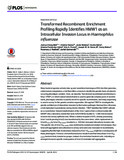Mostrar el registro sencillo del ítem
Transformed recombinant enrichment profiling rapidly identifies HMW1 as an intracellular invasion locus in Haemophilus influenzae
| dc.creator | Mell, Joshua Chang | es_ES |
| dc.creator | Viadas Martínez, Cristina | es_ES |
| dc.creator | Moleres Apilluelo, Javier | es_ES |
| dc.creator | Sinha, Sunita | es_ES |
| dc.creator | Fernández Calvet, Ariadna | es_ES |
| dc.creator | Porsch, Eric A. | es_ES |
| dc.creator | St. Geme, Joseph W. | es_ES |
| dc.creator | Nislow, Corey | es_ES |
| dc.creator | Redfield, Rosemary J. | es_ES |
| dc.creator | Garmendia García, Juncal | es_ES |
| dc.date.accessioned | 2018-09-06T12:20:27Z | |
| dc.date.available | 2018-09-06T12:20:27Z | |
| dc.date.issued | 2016 | |
| dc.identifier.issn | 1553-7374 | |
| dc.identifier.uri | https://hdl.handle.net/2454/30568 | |
| dc.description.abstract | Many bacterial species actively take up and recombine homologous DNA into their genomes, called natural competence, a trait that offers a means to identify the genetic basis of naturally occurring phenotypic variation. Here, we describe “transformed recombinant enrichment profiling” (TREP), in which natural transformation is used to generate complex pools of recombinants, phenotypic selection is used to enrich for specific recombinants, and deep sequencing is used to survey for the genetic variation responsible. We applied TREP to investigate the genetic architecture of intracellular invasion by the human pathogen Haemophilus influenzae, a trait implicated in persistence during chronic infection. TREP identified the HMW1 adhesin as a crucial factor. Natural transformation of the hmw1 operon from a clinical isolate (86- 028NP) into a laboratory isolate that lacks it (Rd KW20) resulted in ~1,000-fold increased invasion into airway epithelial cells. When a distinct recipient (Hi375, already possessing hmw1 and its paralog hmw2) was transformed by the same donor, allelic replacement of hmw2AHi375 by hmw1A86-028NP resulted in a ~100-fold increased intracellular invasion rate. The specific role of hmw1A86-028NP was confirmed by mutant and western blot analyses. Bacterial self-aggregation and adherence to airway cells were also increased in recombinants, suggesting that the high invasiveness induced by hmw1A86-028NP might be a consequence of these phenotypes. However, immunofluorescence results found that intracellular hmw1A86- 028NP bacteria likely invaded as groups, instead of as individual bacterial cells, indicating an emergent invasion-specific consequence of hmw1A-mediated self-aggregation. | en |
| dc.description.sponsorship | This work was supported by National Institutes of Health Ruth Kirschstein postdoctoral fellowship F32AI084427 (to JCM); a Canadian Institute of Health Research operating grant (to RJR); Genome British Columbia grant SOF122 (to RJR and JCM); the Faculty of Pharmaceutical Sciences, Canadian Foundation for Innovation (to CN); National Institutes of Heath R01 grant DC002873 (to JWSG); and (to JG) grants from Ministerio Economía y Competitividad-MINECO SAF2012-31166 and SAF2015-66520-R, Dpto. Salud Gobierno Navarra 359/2012 and Ministerio de Educación PRX12/00191. | en |
| dc.format.mimetype | application/pdf | en |
| dc.format.mimetype | application/zip | en |
| dc.language.iso | eng | en |
| dc.publisher | Public Library of Science | en |
| dc.relation.ispartof | Plos Pathogens, 12(4): e1005576 | en |
| dc.rights | © 2016 Mell et al. This is an open access article distributed under the terms of the Creative Commons Attribution License, which permits unrestricted use, distribution, and reproduction in any medium, provided the original author and source are credited. | en |
| dc.rights.uri | https://creativecommons.org/licenses/by/4.0/ | |
| dc.subject | Transformed recombinant enrichment profiling (TREP) | en |
| dc.subject | Haemophilus influenzae | en |
| dc.subject | HMW1 | en |
| dc.title | Transformed recombinant enrichment profiling rapidly identifies HMW1 as an intracellular invasion locus in Haemophilus influenzae | en |
| dc.type | info:eu-repo/semantics/article | en |
| dc.type | Artículo / Artikulua | es |
| dc.contributor.department | IdAB. Instituto de Agrobiotecnología / Agrobioteknologiako Institutua | es |
| dc.rights.accessRights | info:eu-repo/semantics/openAccess | en |
| dc.rights.accessRights | Acceso abierto / Sarbide irekia | es |
| dc.identifier.doi | 10.1371/journal.ppat.1005576 | |
| dc.relation.projectID | info:eu-repo/grantAgreement/MINECO//SAF2012-31166/ES/ | en |
| dc.relation.projectID | info:eu-repo/grantAgreement/MINECO//SAF2015-66520-R/ES/ | en |
| dc.relation.publisherversion | https://doi.org/10.1371/journal.ppat.1005576 | |
| dc.type.version | info:eu-repo/semantics/publishedVersion | en |
| dc.type.version | Versión publicada / Argitaratu den bertsioa | es |
| dc.contributor.funder | Gobierno de Navarra / Nafarroako Gobernua, 359/2012 | es |



